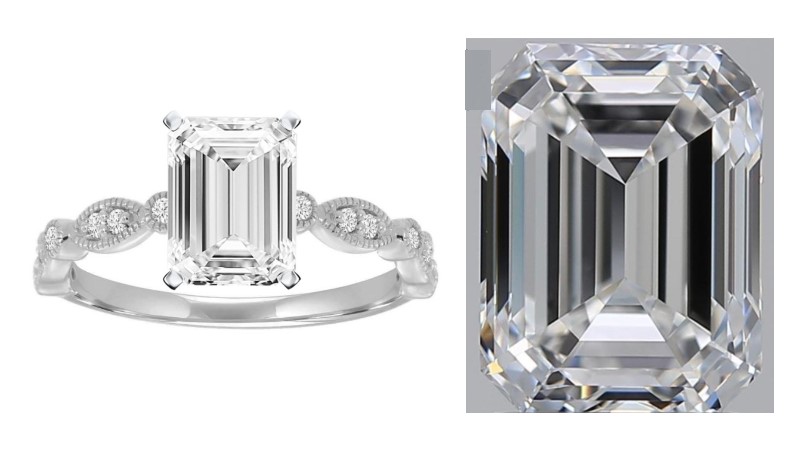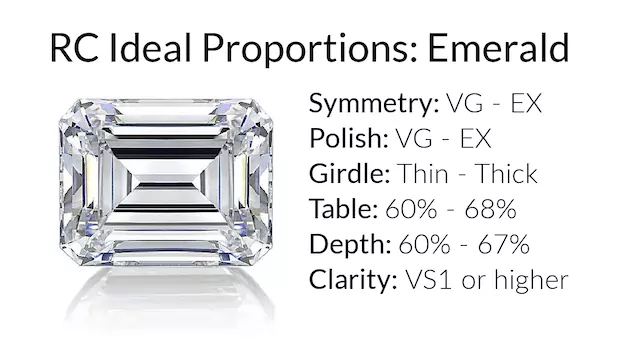What does an emerald diamond cut look like?

An emerald diamond cut is a rectangular or square-shaped diamond with step-cut facets and beveled corners. Unlike the brilliant-cut diamonds with numerous facets, the emerald cut features long, linear facets that create a hall-of-mirrors effect. This cut highlights the diamond's clarity and color, making it an elegant choice for those who appreciate a sophisticated and timeless look. The emerald cut is known for its understated elegance and is often favored in both engagement rings and other jewelry pieces.
With one of the emerald diamonds on your finger, you are going to look fancy.
Word of warning, though, if you are looking for an emerald diamond to be all sorts of sparkly, it’s the wrong stone for you. What it will give you, however, is a timeless and elegant vibe. And you know what they say, if it’s good enough for Beyoncé, it’s good enough for me.
Let’s go through some of the pros and cons of emerald cut diamonds so you are fully prepared to go into battle...
The Pros
The main plus when it comes to emerald cut stones is that you can definitely get more bling for your buck if you play your cards right. The secret is all in the way the cut and the depth work together, you see. In round stones (and any brilliant cut diamond in fact), the ‘brilliance’ comes from the light bouncing around within. Now, in order to get that bounce, the stone needs to have a certain depth and because of this, most brilliant cut diamonds hold a lot of their weight underneath the table where – let’s face it – it is completely wasted. In the immortal words of Sweet Brown, ain’t nobody got time for that.
Emerald cuts rise above all of that nonsense with their ‘step’ cut. The step cut provides a double whammy of awesomeness because not only does it give your diamond some insane flashes of light (known as the hall of mirrors effect), it also eliminates the need for excessive depth in the stone. What does this mean for you, savvy buyer extraordinaire? It means that most of that gorgeous carat weight will be sitting pretty right up top where people can see it.
So, the shallower the emerald cut is, kids, the bigger the diamond will appear. POW! Keep that depth percentage as low as you can (under 67% is awesome), and you’ve got yourself a formidable rock.
Color, Clarity, and Words of Caution
Now for the cautionary tales. Unfortunately, emerald cut diamonds (like my first boyfriend) are not very forgiving. Unlike the brilliant cuts which can hide a multitude of sins, emerald cut stones are like that Aunt who will gleefully point out your flaws for the world to see...
This means that you need to be extra picky about color and clarity if you want to that stone to be ‘on fleek’.

Don’t go below ‘H’ color if you want to avoid any warm tones in the stone. There’s no need to go up to ‘D’ of course, floating around the ‘F-G’ area should be perfectly fine. Clarity is an even bigger issue, though. Inclusions that would be hidden with a brilliant cut will be easily identifiable in an emerald cut.
Personally, if you are going below VS2 in clarity, I think you are asking for trouble. Now that is not to say that there have not been instances of SI1 clarity emeralds seen in the wild, but they are few and far between. I say VS2 is the way to go; however, make sure you see a picture of the diamond (and a diamond plot) to see where exactly those inclusions are sitting. Also, speak with a gemologist about it - they will help you determine if the stone is eye clean. This background check will help you avoid any nasty surprises further on down the road...

Proportions and Polish
In terms of length-width, most people agree that the best ratio for emeralds is 1.40 - 1.50.

Like all non-rounds, there are no overall ‘cut’ grades given for emeralds by GIA – just polish and symmetry. So set that filter to Rare Carat Ideal - it'll set the polish, symmetry and proportions to the ideal ranges we suggest. And remember, you can also enter your GIA number into our free review service and an unbiased gemologist can take a look at the cut and proportions and what have you.
Still Not Sure the Emerald Cut is Right For You?
Read these articles for more insight!
- Rising in Popularity: The Emerald Cut
- Emerald Cut Diamond Ring Guide
- What is an Emerald Cut?
- Whats the best cut grade for this shape? Read more here!
- Made a decision? Shop Emerald Cut Diamonds
Read these articles for other Shapes and Cuts;
- Marquise diamond cut buying guide
- Heart diamond cut buying guide
- Cushion diamond cut buying guide
- Oval diamond cut buying guide
- Round diamond cut buying guide
- Radiant diamond cut buying guide
- Pear diamond cut buying guide
- Asscher diamond cut buying guide
- Princess diamond cut buying guide
Are emerald cut diamonds more expensive?
What is an emerald cut diamond?
Do emerald cut diamonds sparkle?
What clarity do I need for an emerald cut to be eye clean?
Follow Us on Social: Facebook * Instagram * Pinterest * Twitter


